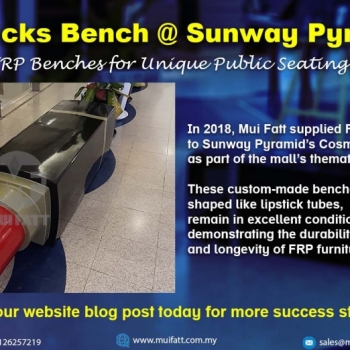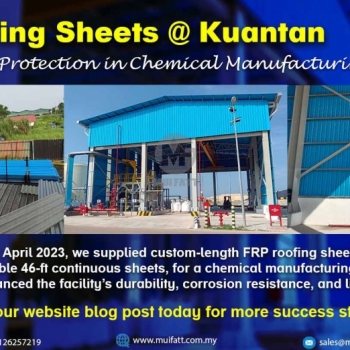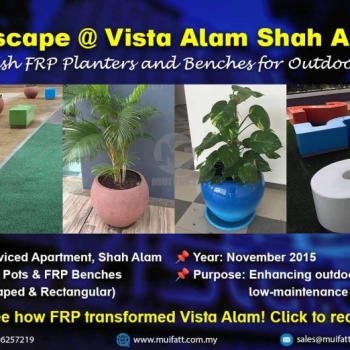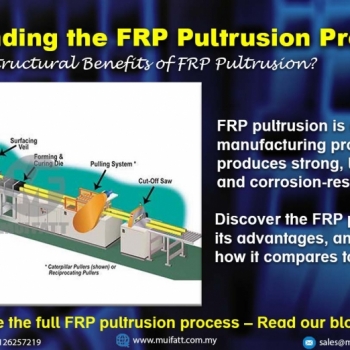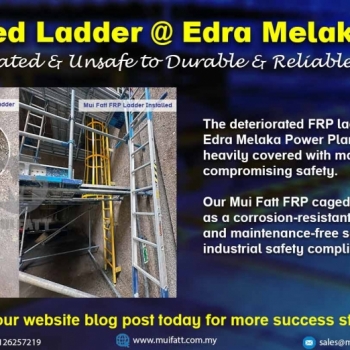In 2024, Mui Fatt supplied 915 custom FRP bollards to Majlis Perbandaran Muar (MPM), Johor, enhancing urban aesthetics and pedestrian safety along Jalan Maharani and Jalan Petrie. Designed in black and gold with the MPM logo, these durable, corrosion-resistant bollards offer a long-lasting alternative to traditional metal options, reinforcing Muar’s identity as Bandar Diraja.
Rotomolding vs. Injection Molding for Plastic Dustbins: Pros and Cons
09 May 2023

Dustbins play a crucial role in waste management, and selecting the right manufacturing process is essential for creating durable, efficient, and cost-effective solutions.
When it comes to manufacturing plastic dustbins, there are several methods to choose from, but two of the most common methods are rotational molding and injection molding. While both methods are effective for producing high-quality, durable dustbins, they each have their own advantages and disadvantages.
In this article, we’ll delve into the two most popular methods for producing plastic dustbins: rotational molding and injection molding. By comparing their respective strengths and weaknesses, we aim to help you make an informed decision when choosing the right dustbin for your needs.
Why Rotomolding is the Ideal Method for Manufacturing Plastic Dustbins?
 Rotational molding, or rotomolding, is a manufacturing process that involves heating a hollow mold filled with plastic resin and rotating it on two perpendicular axes. This rotation distributes the plastic resin and creates the desired shape. Once the plastic cools and solidifies, the final product is removed from the mold.
Rotational molding, or rotomolding, is a manufacturing process that involves heating a hollow mold filled with plastic resin and rotating it on two perpendicular axes. This rotation distributes the plastic resin and creates the desired shape. Once the plastic cools and solidifies, the final product is removed from the mold.
Rotomolding is known for its ability to produce large, hollow, and complex shapes with consistent wall thickness throughout the part. This makes it a popular method for manufacturing plastic dustbins, water tanks, septic tanks, and playground equipment.
Advantages of Rotomolding for Plastic Dustbins
- Boast seamless construction and even wall thickness, resulting in superior durability and impact resistance
- Accessible for small to medium production runs
- Can produce large, hollow, and complex shapes with consistent wall thickness throughout the part
- Can produce dustbins with intricate designs, curves, and contours
- Can produce dustbins with various features, such as built-in handles or locking mechanisms
- Can use a variety of materials, including recycled plastics

- Low tooling costs compared to injection molding
Disadvantages of Rotomolding for Plastic Dustbins
- Limited to smaller production volumes compared to injection molding
- Longer production cycles compared to injection molding
- Limited to certain types of shapes and sizes
The Pros and Cons of Injection Molding for Plastic Dustbins
 Injection molding is a high-volume production method that involves melting plastic pellets and injecting the molten plastic into a mold cavity. The mold is then cooled and the solidified part is ejected from the mold. This process is highly efficient and allows for mass production of uniform and intricate parts. Injection molding is typically used for parts that have complex geometrics, such as dustbins with curved or rounded shapes.
Injection molding is a high-volume production method that involves melting plastic pellets and injecting the molten plastic into a mold cavity. The mold is then cooled and the solidified part is ejected from the mold. This process is highly efficient and allows for mass production of uniform and intricate parts. Injection molding is typically used for parts that have complex geometrics, such as dustbins with curved or rounded shapes.
Advantages of Injection Molding for Plastic Dustbins
- Can produce high volumes of parts with consistent quality
- Can produce dustbins in a wide range of sizes and colors

- Can produce parts with complex geometries and precise dimensions
- Shorter production cycles compared to rotomolding
Disadvantages of Injection Molding for Plastic Dustbins
- Higher tooling costs compared to rotomolding
- Limited to certain types of shapes and sizes
- Limited flexibility in material choices
- Can sometimes be less durable, especially when subjected to impacts or heavy loads
Choosing the Best Manufacturing Method for Your Plastic Dustbins
Both rotomolding and injection molding are effective methods for producing high-quality, durable plastic dustbins, with their own merits and drawbacks. The choice of manufacturing method will depend on various factors such as the required production volumes, the desired properties of the plastic material, the shape and size of the dustbin, and the available equipment and resources.
Rotational molding offers superior durability, design flexibility, and lower tooling costs, while injection molding is ideal for creating intricate designs and cost-effective solutions for large-scale production.
Ultimately, the choice between these manufacturing methods depends on your specific requirements for durability, design, and budget. By understanding the differences between these two processes, you can make an informed decision and select the best dustbin for your waste management needs.
Looking for more information about trash bins, recycling bins, and dumpsters, or looking to order your own? Contact us today! WhatsApp or email – sales@muifatt.com.my
We guarantee our expertise to you.
Visit our product page for more product details – Polyethylene Litter Bins
References:
- Scholarly articles or books on manufacturing processes:
R. J. Crawford, "Plastics Engineering," 3rd Edition, Elsevier, 1998. This book provides comprehensive information on plastic materials and their manufacturing processes, including injection molding and rotational molding.
- Industry publications and trade journals:
- Rotational Molding Magazine (https://rotomolding.org/): This magazine is a valuable resource for news, insights, and research on rotational molding, its applications, and its advantages.
- Plastics Technology Magazine (https://www.ptonline.com/): Plastics Technology covers injection molding, rotational molding, and other plastic processing techniques, providing insights into the latest trends, best practices, and research.
Disclaimer:-
The information provided on this website is for general informational purposes only and does not constitute legal advice. While we strive to ensure the accuracy and reliability of the information provided, we make no representations or warranties of any kind, express or implied, about the completeness, accuracy, reliability, suitability, or availability concerning the information contained herein. Any reliance you place on such information is therefore strictly at your own risk. This website may contain links to other third-party websites. Such links are only for the convenience of the reader, user, or browser; which we do not warrant, recommend, endorse, or assume liability for the contents of the third-party sites.
Keep in touch with us should you be keen on receiving timely updates from us
- Website - https://www.muifatt.com.my/home/
- Facebook - https://www.facebook.com/muifattmarketing
- Instagram - https://www.instagram.com/muifattmarketing/
- Google - https://goo.gl/maps/WxVY13gNcaRTS7Jp6
- Youtube - http://www.youtube.com/@MuiFattMarketing
- TikTok - https://www.tiktok.com/@muifattmarketing
- LinkedIn - https://www.linkedin.com/company/mui-fatt-marketing-sdn-bhd-
- Linktree - https://linktr.ee/muifattmarketing
- Shopee - https://www.shopee.com.my/muifattmarketing
- Lazada - https://www.lazada.com.my/shop/mui-fatt-marketing
Recent Blog
FRP Lipstick Benches for Sunway Pyramid’s Cosmetic Floor
In 2018, Mui Fatt supplied 6-8 FRP Lipstick Benches to Sunway Pyramid’s Cosmetic Floor, Ground Level, as part of the mall’s thematic interior design. These custom-made benches, shaped like lipstick tubes, remain in excellent condition, demonstrating the durability, aesthetic appeal, and longevity of FRP furniture.
Cut-to-Length FRP Roofing Supplied for Chemical Plant in Kuantan
In April 2023, we supplied custom-length FRP roofing sheets, including a remarkable 46-ft continuous sheet, for a chemical manufacturing plant in Kuantan. Primarily in Riviera Blue, with translucent sheets for natural lighting, the shipment was delivered in a single trip using a 46-ft flat loader. This project enhanced the facility’s durability, corrosion resistance, and light optimization.
FRP Planter Pots & Benches for Vista Alam, Shah Alam
In November 2015, Mui Fatt supplied high-quality FRP planter pots and FRP benches to Vista Alam Serviced Apartment, Shah Alam, enhancing the condominium's common areas with long-lasting and aesthetically pleasing outdoor furniture. The project featured sand-gritted earth-colored and two-tone blue FRP pots in various sizes, along with uniquely designed number-shaped and rectangular FRP benches. These weather-resistant and low-maintenance solutions provided functional and decorative enhancements to the living environment.
The FRP Pultrusion Process: A Guide to Strength & Efficiency
FRP pultrusion is a continuous manufacturing process that produces strong, lightweight, and corrosion-resistant profiles. This article explains how the process works, its advantages, and how it compares to other FRP fabrication techniques, helping you choose the right material for your project.
Supplying FRP Caged Ladders to Edra Melaka Power Plant: Safe & Durable Access Solutions
In 2024, we supplied and installed 19 FRP caged ladder units at Edra Melaka Power Plant (EMPP) in Alor Gajah, Melaka. The 6-meter-high ladders were installed in the seawater storage area to replace existing FRP ladders that had accumulated clam attachment byssal threads, which compromised their safety and durability. Our team of 10 workers completed the installation within three weeks, ensuring a seamless transition and an opportunity for skill enhancement.
FRP Planter Pots Enhancing Majlis Perbandaran Jasin (MPJ), Melaka’s Urban Landscape
In 2023, Mui Fatt successfully supplied nearly 1000 FRP planter pots to Majlis Perbandaran Jasin (MPJ), Melaka. These fiberglass planters were delivered in two phases—first, for decorative purposes at MPJ’s office front yard with LED-integrated translucent pots, and second, to enhance various locations throughout the city, including road dividers, roundabouts, and public facilities. Our weather-resistant and long-lasting FRP planter pots contribute to urban beautification while ensuring durability against harsh environmental conditions.
FRP Planter Pots Supplied to Sunway Pyramid for Oasis Opening
Mui Fatt proudly supplied 49 custom FRP planter pots in gold, black, and white to Sunway Pyramid for the Oasis Opening in November 2024. These stylish and durable planters enhance the indoor landscape with a modern touch while offering long-lasting performance. We appreciate Sunway Pyramid’s continued trust in our FRP products.
